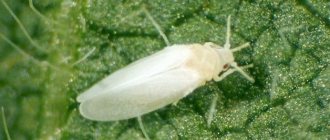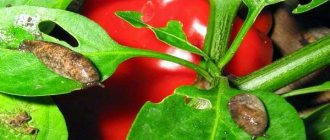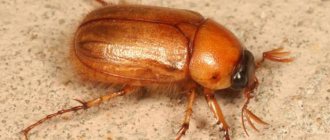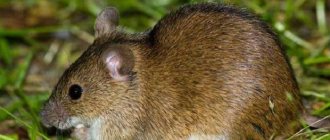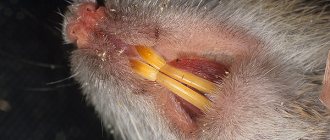The earth rat is considered a dangerous pest of gardens and vegetable plots. The animal belongs to the genus of mice and has nothing in common with rats except the shape and size of the body. The earth rat digs holes like a mole, leaves loose soil on the surface, and feels great in water, so it is important to know how to get rid of the earth rat.
The rodent swims and dives remarkably well. Moves to garden plots and vegetable gardens closer to autumn. Each female reproduces 5 offspring per year. From 2 to 14 cubs at a time. The young female gives birth 2 months after her birth. The main difficulty in fighting the earth rat lies precisely in its fertility. Under favorable development conditions, the number of rodents reaches catastrophic numbers.
Earth rat - appearance, feeding habits
The rodent is considered the largest representative of the vole species. Body length is 25 cm, of which the tail length is 6–13 cm. Weight reaches 500 g. Body color is variable: gray, brown, black, with a white stripe on the back, light sides. But most often these are brown and black tones. The attractive fluffy animal resembles a large mouse or rat.
It feeds on seeds, roots, green parts of plants, and the bark of young trees. It can feast on field mice, mollusks, river animals, and frogs. Stores reserves for the winter. In summer, it settles near water bodies. With the onset of cold weather, it makes its way closer to a person’s home and his lands. You can see the earth rat in the barn, in the beds, in the garden. She deftly crawls through trees, destroys bird nests, feeds on eggs and chicks.
Selects cluttered places with a lot of branches and leaves to build burrows. In addition to passages and burrows, the earth rat builds storerooms. In general, the nest of a ground rat: a hole, a numerous network of passages, a nesting area, and a storage room for the winter. There she takes literally everything that is in the garden: potatoes, onions, beets, legumes, grain. All this is located underground at a depth of 15-20 cm from the surface. If moles live in the area, the earth rat uses its tunnels and does not bother digging new ones.
Habitats
The ground rat prefers to settle near bodies of water. Burrows are found on the banks of swamps, rivers, and lakes. They go 80 cm deep. In length they are placed at a distance of 20 cm from the soil surface.
Deep chambers are intended for wintering. The rodent spends most of its time in the upper ones. Earth rats build entire labyrinths with several entrances and exits, chambers for storing food supplies, and nests. They build nests from all available materials - grass, sticks, twigs, needles, paper, pieces of fabric. There the rat rests and breeds.
Ground rats are forced to leave their previous habitats by unfavorable conditions - flood, drought, lack of food, premature frosts. In this case, rodents make their way to fields, orchards, and vegetable gardens, causing significant damage to crops.
Ground rat in the garden
It is not difficult to guess that with a large number of pests in one area, the entire crop may suffer. The rat stuffs small potatoes into the pantry, and gnaws large ones on the spot. The same thing happens with carrots and beets. In addition to stealing the crop and damaging it, the earth rat damages all vegetation with its moves. They are located close to the surface of the earth. In the process of digging, the rat touches roots and stems. They end up on the soil surface, dry out over time, and the plant dies. In Holland, the ground rat is considered a dangerous pest of tulips. There is nothing in the garden or flower beds that a rodent would disdain. Even weeds are used.
When harvesting grain crops, mounds on the surface of the ground make harvesting difficult. In addition, the earth rat covers the fallen stems with earth. The pest gnaws the bark of young trees. After a feast of several individuals, the tree dries up. It is difficult to overestimate the damage caused by the earth rat. With strong reproduction, the pest can destroy literally everything. Considering the great fertility of the earthen rat, the reaction to the presence of rodents in the garden should be immediate.
Rat control methods
There are several ways to rid your garden of rodent infestations: poisoning, expelling, catching. The choice of control methods depends on the number of pests and on a person’s personal preferences.
Rodents are exterminated using:
- biological method;
- mechanical;
- chemical.
The advantage of these control methods is the complete destruction of pests and quick results. But sometimes it’s easier to simply expel pests from your territory. They also do this in several ways: using folk recipes, using professional equipment. Rats are extremely sensitive to odors, so they can be driven out using strong-smelling substances, and even plants.
Biological control method
The main enemies of rats are cats and dogs. In this case, it is necessary to take into account the fact that the earthen rat reaches large body sizes and can weigh 0.5 kg. Not every cat can handle it. Moreover, today's pets are not particularly keen on hunting. Their true instincts are dormant. It's not always possible to force someone to chase a hefty rat. Special types of dogs are slightly more effective weapons. For example, a dachshund will compete with a rat. If there is one, the problem with pests in the garden is practically solved.
Biological weapons are inherently convenient. It does not require any effort from a person, hunting animals eat their prey, and there is no need to look for dead carcasses. Or they put them in a certain place.
Mechanical method of fighting
Since ancient times, the main weapons against rats have been traps and snares. Currently, they are also being used with success. Special arc traps are used that are buried in the ground at a depth of about 15–20 cm. They are not sprinkled with earth on top. They are located near the entrance to the hole. In addition to these traps, cylindrical traps and self-made structures are used. Professional means of destruction include electronic traps. An electric current is supplied to them. The rodent is exposed to electric current and dies on the spot.
The control method is quite effective, but not always effective. Rats are considered smart, cunning animals. They can avoid traps and snares after seeing how a relative suffers once. The effect of destruction in the first days, then no special results are observed. In addition, other animals, including pets, may fall into the trap.
Chemical extermination of rodents
When you see a rat in the garden, the first thing that comes to mind is to poison it. Currently, the choice of these funds is so large that you can get confused. They have different effects: some cause suffocation, others paralysis, and others drive you crazy. The result is the same - certain death. The most effective method of exterminating rodents, but requires caution. The poison is scattered near the holes or mixed into food. In order for the animal to willingly eat the bait, it must be fed for several days. For example, treat 2 days in a row with fragrant bread. After the rodents lose their vigilance, they are treated to poisoned bait.
A significant disadvantage is that other animals can be poisoned. Besides. The poison may remain in the soil where vegetables grow. As a result, you can get poisoned yourself if you make mistakes in using the poison. And the last point - rodents will die everywhere, decaying animal carcasses may end up near growing vegetables. Finding all the corpses is almost impossible.
Professional repeller
Currently, electromagnetic repellers are very popular. Its action is aimed at the psyche of rodents. A certain frequency of sound is not perceptible to humans and domestic animals; it affects rodents with great force. The devices operate on mains power or batteries. Each model has its own radius of influence. Rodents are literally going crazy. 2-3 days of continuous influence and they will begin to leave the area. According to reviews, the devices are quite effective indoors, but are less effective outdoors. Another point is that it is unknown how far the pests will go.
Perhaps they will settle in the neighborhood and return again after a while.
Expulsion by folk methods
The ground rat does not like strong odors. There are several ways to free the territory:
- set the rubber on fire and put the smoking one in a hole;
- burn the rabbit skin, stuff the remains into holes;
- pour kerosene on a dead rat carcass, burn it, put the remains in a hole;
- fill the hole with water and soot;
- soak rags in machine oil, kerosene, gasoline, and stick them in holes.
In addition, you can use plants. These creatures cannot tolerate the smells of wormwood, tansy, chamomile, elderberry, hawthorn, and mint. By the way, plants can be used for prevention purposes. You can plant mint and chamomile among the beds.
Whatever method of exterminating a rat is chosen, the main thing is to act quickly. These creatures multiply so quickly that you risk being left without a harvest at all.
What animals make burrows?
Who lives where?
- hole
The badger's home is also
a hole
. - hole
And the fox lives in
the hole
. - Burrow
The desert fox - fennec fox also lives in
a hole
. - Fennec in a hole
The African
animal
, the aardvark, also digs a house for itself -
a hole
in which it lives. - hole
... - Crocodile holes
... - Mole
hole... - Ferret
hole
Mole rat
In many ways it is similar to a mole, although it is larger in size, but the marks it leaves behind are about the same. The main difference is that mole rats are voracious rodents, and the fight against them can be painful and long.
Mole rats are usually no more than 32 cm in length. They have very short legs and gray fur. The tail is not visible, as it is too small, the eyes are reduced and hidden under the skin.
The widest part of a mole rat's body is its head. If you look at the animal from above, it resembles a shovel. The mole rat's front teeth are long and protrude.
This pest especially loves potatoes and carrots; it affects garlic and beets, onions and bulbous flowers. It can also damage other plants, such as corn or beans.
The fight against mole rats, due to their underground lifestyle, is not always effective, but is still possible. Just remember that there is a giant mole rat listed in the Red Book.
Usually, when the entire garden is in holes, the summer resident is not particularly concerned about who did it, just to exterminate the pest. The giant mole rat is distributed mainly in sandy and clayey soils near water bodies.
They can be found in the Caucasus, in Dagestan, near the Terek, Sulak and Kuma rivers. It may turn out that just such a rare animal lives on your site.
Giant mole rat
Common mole rat
Mole rat minks
There are several ways to get rid of the pest.
The first way is to set traps. This method is not very effective, because mole rats are smart and cunning. It is best to get mole traps. When fighting a mole rat, you can be cunning.
Animals do not like open areas and wind, so you can dig up their hole and make another smaller one next door. Place a trap in the hole and cover it with something. When choosing from two options, the mole rat will, of course, choose the more protected one and will most likely fall into a trap.
The second way is to flood the holes. The mole rat is quite helpless against water. But if your soil is sandy and absorbs moisture well, then most likely this method of control will not suit you.
The third way is to use poisons and chemicals. But it may also not work. If there is enough food for a mole rat in your area, then it will not even look in the direction of the poison.
The fourth method and one of the most effective is noise and ultrasound. Mole rats hate noise. Therefore, installing noise repellers will not be superfluous. One of the surest methods is a vibration-sound repeller.
Hare
If moles still bring at least some benefit, then hares on the site cause only harm. True, they are not as frequent guests there as the above-mentioned rodents. In the summer, when there is enough food, a long-eared sprinter may appear in the garden by chance, running past. It will feast on young carrots or juicy cabbage, bite off the tops of other vegetables, and trample the beds.
But in a hungry winter, the bark of garden trees is a hundred times tastier for hares than the sweetest summer carrot. They especially like apple and pear trees, but they won’t pass by cherries and plums either.
Therefore, the gardener’s task is to protect his garden from the teeth of these uninvited guests. This can be done in several ways. The first is to install a fence that animals cannot get over or under. A chain-link mesh is well suited for these purposes. The fence should be no lower than 1 m, and part of the mesh (25-30 cm) should be buried in the ground.
The second way: tie each tree with protective material. This can be a special mesh, roofing felt, or even elastic tights. Hares cannot reach the bark through them.
Third way: use rodent-repellent smells and sounds. You can hang small bells, rustling plastic bags, or long paper ribbons on trees or a fence. Hares are afraid of the smell of gunpowder. You can spread spent cartridges around the area.
Shrew
The animal is similar to a vole, but has two obvious differences - a much longer tail and an elongated muzzle. There are two types of shrews: shrews and shrews.
The shrew reaches a size of no more than 7 cm and is gray in color, but most often a shrew with brown fur and no more than 5 cm in length appears in the garden.
shrew
Shrew
Don’t be fooled by the appearance of the animal, because just how cute a shrew looks in the photo does not mean that the damage from it will be minimal. In just a couple of days, the entire area can be dug up, and the lawn will be full of tussocks.
The shrew has a high metabolism, so it is constantly looking for food, which results in furrows like those in the photo of its burrows.
The baby feeds on insects, and it would be quite useful if the harm it causes were not many times greater than the benefit. In a day, it destroys pests several times its own body weight.
The furrows it creates help the earth to become saturated with oxygen. But the fact is that there is usually practically nothing left to grow on such land - the shrew gnaws through the roots and plants that stand in its way.
The first way to combat shrews is with poisons and chemicals. Products such as Anti-Rodent are used against animals. It is important to remember that the poison can be dangerous for pets or children, so be careful and read the instructions for use.
The second method is to flood the shrews' burrows. In this case, it is better to flood any hole that causes suspicion.
The third way is to use items with a strong, unpleasant odor. Shrews have a very delicate sense of smell, so they cannot tolerate strong-smelling things. Place rotten fish or eggs in the holes. The shrew will not tolerate such aromas and will leave the hole.
Using traps against shrews is ineffective. And any of the above methods does not provide a 100% guarantee. Shrews can easily come back to your site, so you should be very careful.
Useful tips
Professional products for fighting the rat family are produced in different variations. You can offer poison-treated grain to pests, or use gel bait. It contains a potent poison, flavorings to attract the attention of animals, and flavoring additives. It must be placed near the minks.
If the animal dies in a hole, there is nothing to worry about; on the surface, it must be buried so that birds and neighbor cats do not get hurt.
With the constant invasion of voles in gardens, it is necessary to ensure the tightness of the area. Build a fence around it with a cemented base. The animal will not be able to make moves in the cement.
Vole
Looks like an ordinary mouse. Body length is no more than 13 cm. The color is brown, and gray on the tummy. Unlike the shrew, the vole will feed on your crop.
She likes roots, shoots, leaves and sometimes even seeds of some plants (for example, beans). It is even more prolific than the shrew - the field mouse is capable of reproducing offspring up to 7 times per season, 5 and sometimes 12 babies each.
In winter, voles are protected by a layer of fallen snow, so pests may simply not survive snowless winters. In winter, they can harm raspberry bushes and gardens.
Below is a photo of field mouse burrows. Pests usually live in groups and dig branched, complex tunnels. But this happens at a shallow depth - from 15 to 35 cm.
Regular weed removal and timely harvesting can be used to prevent the appearance of voles on your site. But alas, even taking all the precautions cannot guarantee that you won’t get a vole.
So, what to do if field mice are already infested on your property?
The first way is to get a good, not lazy cat. Of course, if you take a kitten, things will not go the fastest, but this method can scare away voles for a long time and protect your area.
It would not be the wisest decision to use traps, since they are effective in the presence of only a few pests, and the number of voles tends to increase quickly.
The second method is poisoned baits and toxic substances. For example, you can make lumps of dry plaster and flour or other treats. Voles love to drink after eating, and gypsum congealed in the stomach will lead to immediate death. You can flood the holes, treat them with poisonous gases, or use an acute poison, after consuming which the animal will die.
Voles are smart, so if you choose a poison, it is better to choose one that the rodent needs to eat once than substances with a cumulative effect.
The third method is smells and noises. A variety of ultrasonic repellers work effectively. Also, voles cannot tolerate the smells of elderberries and nuts, and they really do not like the aromas of essential oils. Therefore, you can put walnut leaves, elderberry, even garlic or a piece of fabric soaked in essential oil or, for example, kerosene in their hole.
The fourth method is ammonium nitrate solution, 3%. It needs to be poured into the hole (about 1 cup) and trampled on top. Ammonia is harmful to voles.
Moles
Most often, gardeners and gardeners think about them when they find randomly located mounds of earth on their site. However, they inadvertently cause damage to plants and lawns.
Mole caught
Moles are insectivores. They feed on any animal objects they encounter on their way. Often their victims are earthworms, which is not very good, but otherwise, moles destroy wireworms, mole crickets, May beetle larvae, weevils and slugs. They do not cause damage to plants on purpose, but only when digging tunnels, when their roots are exposed.
Krawczyk (snow beetle)
A representative of the dung beetle family. Only it differs from its relatives in that it feeds on herbivorous food. It was nicknamed the shear beetle because it literally cuts off plant stems with its powerful jaws.
The beetle is black, up to 2.5 cm in length. Its head is large and very noticeable, for which it is also called the bigheaded fish.
Red minnows dig deep burrows for themselves, which are quite complex and large. This happens mainly in early spring, during the mating period. Then the female begins building a burrow. A common, not yet branched burrow sometimes reaches up to 70 cm in depth.
Spreading
Mainly settles in the steppe, forest-steppe, and in the south in the forest zone. You can also find karbysh along river valleys and in mountainous areas.
He loves cultivated areas: fields, parks, vegetable gardens, but can also live in buildings, even close to people.
Habitat in Russia:
- off the coast of the Black and Azov Seas;
- from the Smolensk region to the Perm region;
- from the Sverdlovsk region to the Krasnoyarsk Territory;
- in the Minusinsk steppe.
Rat
Rats are very smart. And also, like any rodent, they are dangerous because they are carriers of many diseases. In the countryside, you can most often find a gray rat. People call it pasyuk.
It is quite large, can reach 27 cm in size. Pasyuk is omnivorous and swims well. It is he who digs holes in vegetable gardens, not particularly deep, but branched.
The rat is prolific - per year it can give birth to 3 litters of up to 10 cubs each. This large pest will also fight a large enemy if there is no place left to run to. Pasyuk can even attack a person.
Due to the mole cricket's addiction to cabbage, it is also called cabbage.
The cabbage nests are shallow - only 10–15 cm from the surface. In them, the female takes care of her offspring. The nest has many branches and exits.
The female regulates the conditions inside for the best development of the larvae - she opens and closes the entrances, gnaws out the roots of plants so that the nest warms up better. So the root system of plants is sufficiently affected, which leads to their death.
The mole cricket can overwinter in the ground at a depth of up to 2 m, and can also overwinter in manure. Often it is with compost that it ends up in gardens.
Fighting mole crickets, like other pests, is not easy. Getting rid of cabbage weed needs to be approached comprehensively, focusing on its characteristics and habits. Let's look at some preventive and preventive measures.
The first method is loosening and digging. You should try to dig no less than 15 cm deep. This procedure needs to be done about 3 times throughout the entire season. This way you will find mole cricket nests and eggs in the soil.
The soil with eggs must be removed from the garden - poured into a bucket or other container. And if you come across an adult mole cricket, then it also needs to be destroyed - crushed or chopped.
The second way is to lure with manure. In the spring, you can spread heaps of compost around the garden - mole crickets will find this a good place for their nests. Check the piles periodically, and if you find eggs or an adult, destroy them.
For wintering, the mole cricket will also prefer compost. At the end of autumn, dig several holes in which to place manure. When frost sets in, destroy and scatter the manure from the holes. The mole cricket simply won’t have time to hide in the ground and will freeze.
If the mole cricket has already started and can simply destroy your garden until late autumn, then you can remove it as follows.
The first method is detergents. Water mixed with powder or laundry soap and poured into the holes of the cabbage will either kill it or force it to crawl out. Then it can be destroyed manually.
The second way is poisons and chemicals. Preparations such as “Grom” or “Medvetox” can simply be poured into the minks, or they can be mixed with wheat porridge and placed in places that most need protection, or next to the minks. You can also use kerosene against cabbage weeds. The third method is traps. Kapustyankas are very fond of beer and honey. A jar with a small amount of beer (up to 100 g) should be buried at an angle in the ground, leaving the neck at the top.
The neck must be tied with gauze. The mole cricket will gnaw through the fabric and fall into the jar, and it will no longer be able to get out of there. Once the jar is full, the pests can be killed very easily.
If any of the above pests have appeared in your garden, prepare yourself for a long fight and be sure to first determine who exactly is digging the soil in your dacha.
Most likely, some of the methods will not suit you, but there will probably be one that will be life-saving. The best solution would be to use comprehensive control, using all possible methods.
The most dangerous pest of household plots and summer cottages is the ground rat or water vole. The animal belongs to the genus of mice, but has nothing in common with them. The way of life of an earth rat is somewhat similar to the way of life of a mole: it digs passages in the ground, so after its life activity small holes remain in the garden. In addition, the animal feels great in water, which complicates the fight against it.
This text describes the life functions of the earth rat, its harm to humans, as well as effective ways to get rid of this animal. If the presence of a water vole is detected on the site, then you need to immediately begin expelling it from the site. If you do everything correctly, following useful tips, then this procedure will not be so difficult.
Insects and their larvae
Mole mole crickets, ants, leaf miner bees, beetle larvae and long-legged mosquitoes are all unpleasant inhabitants of your lawn. They eat grass roots, dig their passages underground, and throw small mounds of earth to the surface.
In areas of damage, the grass stand becomes weak and thin, and plants are easily pulled out of the ground. Brown or yellow spots appear on the lawn, which are especially noticeable during drought. Adding to the chaos in an insect-infested lawn are birds that actively seek food there, pulling out the turf with their beaks and tearing it with their paws.
Measures to combat insect pests depend primarily on their number. If there are few living creatures, folk remedies can help, such as using traps with taste baits, as well as all sorts of pungent infusions and decoctions; if there are a lot of insects, you cannot do without specialized insecticides. You should also not forget about regular lawn care - spring rolling of the soil, aeration and scarification. You can read more about all these tools and methods in our relevant materials.
- How to get rid of ants on your property forever!
Is it possible to destroy all the ants on the site and, most importantly, whether this should be done - find out right now!
- How to deal with mole crickets - effective drugs and folk remedies
Don’t know how to get rid of mole crickets on your property? Our recipes will help you protect your garden crops from this underground pest.
- May beetle: which plants are threatened and how to deal with its larvae
The appearance of cockchafers in the garden is not a harmless sight, but a serious problem. Don't let pests destroy your plants!
Features of the earth rat
This pest is an excellent swimmer, so it can easily move in any conditions in search of food. In the autumn, he moves closer to country houses and household plots, where he can find food for himself without much effort. The ground rat is distinguished by enviable fertility: the female gives birth to her own kind 5 times in 1 year, in quantities from 2 to 14 tiny living creatures. 2 years after birth, young water voles can already reproduce. Therefore, the difficulty of combating this pest also lies in fertility.
Given favorable conditions, the ground rat is capable of increasing its population to catastrophic proportions. In appearance, the earth rat is a fluffy and very attractive animal that belongs to the order of voles. This pest grows up to 25 centimeters in length, with the tail taking up half of its length. The animal weighs about half a kilogram and has a very variable color - from black to gray, with and without stripes of light colors.
The pest eats various root crops, tops, leaves, and also gnaws the bark of young trees. In addition, the water rat catches frogs, eats shellfish and hunts voles. In the summer, the rodent stays close to bodies of water, where there is enough food for them. Closer to winter, the pest moves closer to humans, settling in gardens or outbuildings. The water vole easily climbs trees in search of chicks and bird eggs.
The pest lives in hard-to-reach places, which are characterized by debris of old branches or unnecessary things. Among other things, the water vole builds pantries underground, where it stores food for future use. Therefore, its burrows represent many passages that are directed to pantries, to the nest, as well as to entry and exit points. She stores for the winter everything she has access to: potatoes, beets, carrots, grain, legumes, etc. The burrows are located at a depth of about 20 cm.
Why is the ground rat dangerous?
Since this harmful animal is highly fertile, it is not difficult to guess how much harm just one water vole colony can cause. A ground rat, if it settles in a country house or on a personal plot, is capable of eating everything that grows in the garden, as well as what is in a person’s home. If there is not enough food for them, then they begin to enter the house, feeding on cereals, bread crumbs, sausage, cheese, etc. In short, everything that a person eats, an earth rat will eat. In addition to the fact that it can eat part of the harvest, it spoils fruit trees and other green spaces, as it makes passages in the ground, violating the integrity of the root system. This leads to a partial loss of the harvest of fruits and berries, and often, after the active life of this animal, fruit trees and shrubs simply dry out.
How to find a nest
The shrew prefers moist soil. They live independently, one at a time. Each digs an individual passage for movement, and they occupy the empty holes of other animals. Sometimes they live in the voids of stumps, in tree trunks, sometimes in human dwellings.
They line their nests with dry grass. Each individual has its own habitat, approximately 10m2. This is quite enough for food.
Effective methods of dealing with earthen rats
The fight against earth rats on a personal plot or in a country house involves several tactical approaches - catching pests, baiting with chemicals or expulsion. Which of these methods to choose depends on several factors, including the number of animals, as well as personal attitude towards one or another method of control. It is quite natural that almost all owners of vegetable gardens and garden plots do not recognize poisons and other chemicals. This is understandable, since poisons can harm not only pests, but also humans themselves, as well as pets. In addition, there is a category of people who have a negative attitude towards inhumane methods of struggle that involve the destruction of living beings, regardless of whether they bring harm or benefit.
Biological method of control
Almost everyone knows that cats are considered the natural enemies of rats and mice, but not everyone knows that dogs, especially some of their breeds, are also enemies of rodents. Naturally, not every cat is able to cope with an adult ground rat, which weighs almost half a kilogram and reaches a length of 25 cm. In addition, special breeds of cats are needed, and those pets that are kept in greenhouse conditions in many houses and apartments are unlikely to want to hunt rats and mice, since they do not lack food. And if you consider that not all cats have a developed hunter instinct, then you can’t really rely on cats in the fight against rodents. An ordinary yard cat can cope with such a task better than a pet with a long pedigree.
There is a breed of dog, the dachshund, that can cope with the task of catching earth rats. Whether the dachshund will eat them or not is a second question, but catching them and putting them in one place is easy. Therefore, the ideal option is to buy a dachshund and watch it chase pests.
Humane methods for getting rid of earth rats
Many owners prefer humane control methods that are aimed at expelling pests from their garden plots, as well as repelling rodents. Regardless of which method of control this or that owner is a supporter of, it is imperative to get rid of the earthen rat. Nowadays, manufacturers have come up with a number of devices, and people have come up with a number of methods that make it possible to expel them from the site without destroying the animals.
For example, you can use:
- Ultrasonic repeller as an effective device that affects the behavior of rodents such as mice and rats. The devices are inexpensive and compact in size. The device works on the principle of generating ultrasonic waves, which humans do not perceive, but some animals perceive these signals. Depending on the level of this signal, mice and rats develop a feeling of fear and anxiety. As a result, they try to leave the range of this device. Unfortunately, rodents begin to get used to these signals, so no one can give a 100% guarantee.
- Flooding of holes . Since the water vole is not afraid of water, it is not in danger of death. Despite this, she will leave the uncomfortable area.
- Smoking pests out of holes. These animals have a highly developed sense of smell, so they cannot tolerate strong, pronounced aromas. They will immediately smell the burning substance and try to escape. In addition, they cannot stand the smell of wormwood and mint, so they can also be used as a deterrent.
- Planting black elderberry . The roots of this plant are a source of cyanide, which saturates the soil. They have a detrimental effect on rodents. At the same time, black elderberry does not have a negative effect on plants growing nearby, and even helps to increase productivity.
To successfully fight an earthen rat, you need to know the peculiarities of its behavior. As you know, there are other ways to humanely treat pests. If you use your wits, you can cope with pests without outside help.
Destruction by toxic substances
Some owners prefer not to stand on ceremony with pests and resort to the use of chemical rodent control agents. Currently, this is not a problem, since a huge number of broad-spectrum chemicals are available on the household market. Some substances cause attacks of suffocation, others paralysis, and some drive you crazy. Although chemicals are highly reliable, their use requires equally great care . Firstly, all medications must be used strictly according to the instructions. It is important to remember that they are poisonous and you can get seriously poisoned.
Folk remedies
As a rule, folk recipes do not contain toxic components, and therefore they can be used in any area without fear of poisoning, both people and animals. Sometimes it is enough to add plants with a strong smell, such as mint, lemon balm, St. John's wort, chamomile, etc., into the holes of earth rats. The same results can be obtained if you use rags soaked in kerosene, gasoline, grease, etc.
Using traps
Traps are the first device that humans used to catch rodents. Nowadays, simple traps have been transformed into more advanced and effective devices that cope with their functions. Arc traps are more suitable for catching earth rats. It is possible to use homemade traps or store-bought ones. When pests fall into such traps, they die immediately. Despite the high efficiency of modern traps, pests have learned to bypass them if at least one adult is in the trap.
Preventive measures
The main reason why a pest settles in a garden plot or country house is the availability of food in an accessible form. Therefore, to get rid of the pest, you need to work hard. If you follow useful tips, you can reduce the risk of a rodent appearing on your property several times. What should be done:
- Get a cat and a dog. These animals will help in the fight against rodents, scaring them away even with their smell.
- Regularly inspect your property for the presence of such rodents.
- Often play loud music on the street or dig several sticks in the area, hanging several tin cans on them. When exposed to wind, the jars will make loud sounds, which will repel pests.
- Frequently clean up the house, throwing out old, unnecessary things. A pile of junk attracts many parasites.
The water vole can cause a lot of harm if you do not start fighting it in time. It is important to choose the right way to get rid of the pest without causing damage to yourself, pets and plants.
- Author: Maria Sukhorukikh
Rate this article:
- 5
- 4
- 3
- 2
- 1
(1 vote, average: 5 out of 5)
Share with your friends!
Jerzy
Hedgehogs also belong to the same family as moles (Insectivores).
First of all, hedgehogs are useful creatures that actively exterminate slugs, caterpillars, small rodents, insect pests and their larvae in the area. If you do not try to pick up a hedgehog (and it can bite and serve as a carrier of parasites and some diseases), you are guaranteed mutually beneficial coexistence on the site.
Another thing is the lawn. In search of underground inhabitants for food, a hedgehog may well make “excavations” there, leaving sloppy holes and pulled out turf on the surface. Hedgehogs can also settle in old rodent burrows, expanding them, although choosing secluded places for this, and not in the middle of the lawn.
To prevent the hedgehog from spoiling the lovingly grown grass cover, simply try to “relocate” the bully to another corner of the site, carefully moving him there and, for example, getting into the habit of feeding him something tasty from time to time away from the precious lawn. The animal has an excellent sense of smell, so it will certainly smell the food and come to your “dining room”. In the end, you can take the hedgehog into the forest, but under no circumstances kill it.
- Hedgehogs in the country: secrets of mutually beneficial neighborhood
We answer the questions: how to attract hedgehogs to the site and is it necessary to do this?
